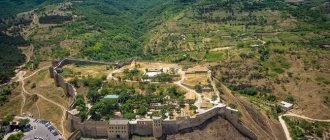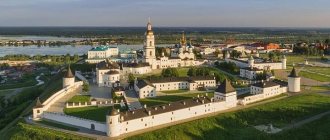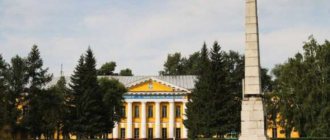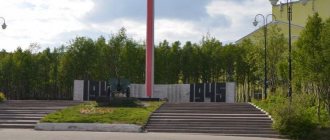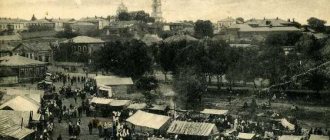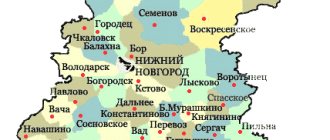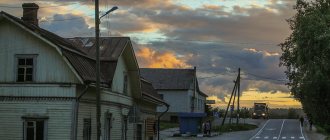HomeHome page For tourists Where to go on vacation
Where in Russia can you conquer the highest peaks of the circumpolar Urals, go on extreme tours and trophy fishing, visit a huge oceanarium and try Siberian delicacies? We answer - in Ugra. Read our special review of what tourists can do in the Khanty-Mansiysk Autonomous Okrug - Ugra.
YUGRA IS NOT ONLY OIL AND BIATHLON
When they talk about Ugra, first of all they remember about oil and gas and, secondly, about biathlon. Khanty-Mansiysk Autonomous Okrug - Yugra is one of the most oil-bearing regions in the world, the energy heart of Russia. On May 20, 2022, the 12 billionth ton of “black gold” was received here.
Khanty-Mansiysk has hosted international skiing competitions many times.
But the third reason to remember Ugra is tourism. The northern region is capable of surprising, conquering and making any traveler fall in love with it, because its territory contains historical and cultural monuments, archaeological and museum complexes, the traditions of the indigenous peoples of the North are represented, and a modern infrastructure has been created for lovers of cultural, active and family recreation.
And Yugra is also the mountains of the Subpolar Urals, great rivers, trophy fishing and real Siberian delicacies.
LiveInternetLiveInternet
Many people believe that in order to uncover the unknown secrets of civilization, it is necessary to go to other continents: to plow the seas, cross deserts and climb through the jungle. Meanwhile, in Russia there are peoples whose way of life, traditions and views on life can surprise or even shock. For example, the Mansi and Khanty, who have lived in the vast expanses of Ugra since ancient times, have posed many questions to historians and ethnographers, the answers to which have not yet been found.
These are two different peoples
Despite the unconditional kinship, which is expressed in the similarity of languages and many rituals, the Khanty and Mansi are different peoples. But it just so happened that the colonialists of Western Siberia, representing the interests of the Russian Empire, had no time to identify ethnographic differences. Residents of Ugra were mentioned in droves both in official documents and in scientific research. This approach led to the emergence of the Khanty-Mansiysk Autonomous Okrug. The common name that scientists came up with to justify the unification of the two peoples sounds like “Ob Ugrians.” Since these people live in the Ob basin and belong to the Finno-Ugric peoples. By the way, their closest relatives, according to linguists, are the Hungarians (Magyars). Khanty, Mansi and Hungarian are part of the Ugric group of the Uralic language family. It is believed that the ethnogenesis of the two indigenous peoples of Western Siberia occurred in the Urals as a result of the mixing of local residents who lived on these lands since the Neolithic era and Finno-Ugric tribes that came from the south. Then both the Khanty and the Mansi were forced out to the northeast by their warlike neighbors. [С-BLOCK] The main difference between the two above-mentioned peoples is their way of life. Mansi (Voguls) are nomadic reindeer herders inhabiting the tundra. Their life corresponds to their main occupation. Although they also hunt, the production of fur-bearing animals has never been their main source of income.
The Khanty (Ostyaks) live in the taiga and along the banks of the Ob, Irtysh, and their tributaries. They are skilled hunters and fishermen. Initially, these people lived only by fishing, and also collected what the forest provided. Therefore, among the Khanty, the cult of worshiping the spirits of trees is no less developed than the veneration of totem animals. However, starting from the 19th century, many Khanty took up reindeer herding. The habitat and main activity of the Voguls and Ostyaks, as they were called before, are different, and therefore their way of life is different. According to the 2010 Russian population census, the number of the Khanty people exceeds 30 thousand people, the Mansi are much smaller - only about 12 thousand representatives.
Sacrifices to icons
Traditionally, the Khanty and Mansi adhered to pagan beliefs. They worshiped gods, nature spirits, totem animals, trees, and deceased ancestors. The shaman was the indisputable authority for them. And although the Ob Ugrians officially adopted Christianity, their worldview surprisingly combines animism, zoomorphism and Orthodoxy. These people continue to follow their traditions. True, with the massive settlement of Siberia by Russian colonists, they began to practice their cults secretly, moving idols to special places that serve the pagans as sanctuaries. There they bring various offerings to their gods and spirits, which they worship. Sometimes the Khanty and Mansi smear the blood of sacrificial animals on the lips of saints depicted on Orthodox icons, which are found in almost every home, because they perceive these faces as pagan gods. Thus, the supreme god, called Num-Torum, is associated here with Nicholas the Pleasant, because it is to him that believers turn if they need help in a specific matter. For example, in moose hunting. And the earth goddess Kaltas-ekva is perceived by local believers as the Mother of God. So far, Orthodox priests cannot do anything about such religious syncretism, because in words the Mansi and Khanty are Christians.
Celebrating the killing of a bear
Many peoples of Siberia consider the bear to be their ancestor, including the Khanty and Mansi. But religious worship does not prevent them from killing this animal, skinning it and eating the meat. On the contrary, every “master of the taiga” caught by taiga hunters is a reason to organize a holiday for all residents of the settlement. Moreover, if the victim is a bear, then the general fun lasts 4 days, and the killing of the bear is celebrated a day longer. Ritual actions accompany the cutting of the animal carcass. They skin him solemnly, in front of a large crowd of people. The head is placed between the front paws, they are left untouched. Silver coins are placed on the nose and eyes of the killed male, and a muzzle made of birch bark is placed on the mouth. The female is decorated in a different way: a woman's scarf is thrown over her head, and beads are placed around her. If we consider that every local family has a bear skin, and even more than one, then we can assume that the hunt for the “masters of the taiga” in Western Siberia was carried out regularly. At the festival, people not only treat themselves to fresh bear meat and other dishes of national cuisine, they sing ritual songs, dance, and stage comic performances. Moreover, the actors are exclusively men who perform female roles, dressed in the clothes of their relatives. The Bear Festival is an alternative reality, a kind of looking glass where the world of spirits intertwines with reality.
Allows adultery
Representatives of the indigenous peoples of Ugra do not strictly monitor the behavior of their daughters, because premarital relations are not considered something reprehensible among them. Having a child from another man does not in any way prevent a girl from deciding to get married. From the groom’s point of view, this is a positive thing, because his chosen one has proven that she is able to bear and give birth to healthy offspring. But infertility is a real tragedy in the eyes of the Khanty and Mansi. They even allow adultery if a woman cannot get pregnant from her husband. In case of infertility of the first chosen one, the man is allowed bigamy. These people believe that a difficult birth indicates the lady’s infidelity, because this is how the gods themselves punish her - when she gives birth to a child not from her official spouse, she experiences much more suffering and pain than a decent woman. And the affairs of the gods do not concern mere mortals. And every child is greeted with joy.
Castrating deer with teeth
Muncie, as a rule, keep large herds of deer. The meat of these animals is eaten, traditional clothing is made from the skins, and the horns and bones are used to make various tools and household utensils. Sometimes deer are used to pay with each other. In a large herd, one (less often two) male breeder is left. He inseminates females during the rutting period. Most grown-up male animals are castrated: otherwise they will begin to fight fiercely for the fawns, which is fraught with losses for the owners. In addition, after castration, former males gain weight better. In the old days, not having the necessary tools and fearing infection of animals, the Mansi would bite the eggs of young deer to be castrated... with their own teeth. This became a tradition that some livestock farmers still follow today.
They eat the contents of deer stomachs
Many peoples of the world can surprise you with their national dishes. And the indigenous people of Siberia are no exception. They eat not only the insides of deer, but also the contents of their stomachs. This delicacy is called “kanyga”; in winter it usually consists of semi-digested reindeer moss, and in summer - from the leaves of shrubs, grass, lichens and mushrooms exposed to the gastric juices of a deer. It is believed that kanyga is very useful; it promotes the digestion of animal food. To enrich it with vitamins and microelements, this dish is consumed together with northern berries: lingonberries, blueberries and others. In addition, Mansi and Khanty drink the blood of a freshly slaughtered deer, and also eat bone marrow from the legs of the animal, breaking them with the butt of an ax. Raw meat, while it is still warm, according to the natives of Ugra, helps against many diseases, strengthens a person’s immune system, gives him strength and warms him from the inside, which is important during severe frosts.
Blood feud
The tradition of blood feud is widespread among the Khanty. Sometimes families have been at odds with each other for generations. For the murder of a relative, it is customary here to take revenge on the family of the perpetrator of the crime. Interestingly, this custom also applies to bears. If the “owner of the taiga” takes the life of a hunter who came to the forest for prey, then the relative of the deceased must go to the taiga and punish the clubfooted criminal. Moreover, the corpse of such a killer bear is supposed to be burned, and no holiday should be held in his honor.
Play 27 instruments
The musical culture of the Ob Ugrians is much richer and more diverse than that of most of their neighbors. Thus, the Khanty and Mansi have long learned to make a variety of stringed instruments. Researchers have counted 27 species, each of which is associated with some kind of totem animal or pagan ritual. For example, a seven-string harp is a swan. And there is also the tumran, nars-yuh, nonryp, kugel-yuh, nin-yuh and many other musical instruments.
Air burial rite
One of the oldest funeral traditions is air burial. Although the word “burial” is clearly not suitable here, because during the funeral the body of the deceased is hung on a special crossbar or left on a high platform in a special place. Some peoples who adhere to pagan beliefs do this so that a person’s soul can fly through the air to another world for the next incarnation. Not only individual Khanty and Mansi people bury their dead in this way, but also some Nenets, Nganasans, Itelmens, Yakuts, Tuvinians, Altaians and others, including the Iroquois of North America.
Rambler reports this.
Further:
https://weekend.rambler.ru/read/41497169/?utm_cont...d_more&utm_source=copylink
Initially, the Mansi people lived in the Urals and its western slopes, but the Komi and Russians forced them out into the Trans-Urals in the 11th-14th centuries. The earliest contacts with Russians, primarily with Novgorodians, date back to the 11th century. With the annexation of Siberia to the Russian state at the end of the 16th century, Russian colonization intensified, and already at the end of the 17th century the number of Russians exceeded the number of the indigenous population. The Mansi were gradually forced out to the north and east, partially assimilated, and in the 18th century they were formally converted to Christianity. The ethnic formation of Mansi was influenced by various peoples. In scientific literature, the Mansi people together with the Khanty people are united under the common name Ob Ugrians. In the Sverdlovsk region, Mansi live in forest settlements - yurts, in which there are from one to 8 families. The most famous of them are Yurta Anyamova (Treskolye village), Yurta Bakhtiyarova, Yurta Pakina (village of Poma), Yurta Samindalova (village of Suevatpaul), Yurta Kurikova, etc. The rest of the Ivdel Mansi live dispersedly in the villages of Vizhay (now burned down), Burmantovo, Khorpiya, on the territory of the city of Ivdel, as well as in the village of Umsha
There is no consensus among scientists about the exact time of formation of the Mansi people in the Urals. It is believed that the Mansi and their related Khanty arose from the merger of the ancient Ugric people and the indigenous Ural tribes about three thousand years ago. The Ugrians inhabiting the south of Western Siberia and the north of Kazakhstan, due to climate change on earth, were forced to migrate north and further to the northwest, to the region of modern Hungary, Kuban, and the Black Sea region. Over several millennia, tribes of Ugric herders came to the Urals and mixed with the indigenous tribes of hunters and fishermen.
The ancient people were divided into two groups, the so-called phratries. One was made up of the Ugric newcomers "Mos phratry", the other - the Ural aborigines "Por phratry". According to a custom that has survived to this day, marriages should be concluded between people from different phratries. There was a constant mixing of people to prevent the extinction of the nation. Each phratry was personified by its own idol-beast. Por's ancestor was a bear, and Mos was the Kaltash woman, manifesting herself in the form of a goose, butterfly, and hare. We have received information about the veneration of ancestral animals and the prohibition of hunting them. Judging by the archaeological finds, which will be discussed below, the Mansi people actively participated in hostilities along with neighboring peoples and knew tactics. They also distinguished the classes of princes (voevoda), heroes, and warriors. All this is reflected in folklore. Each phratry, for a long time, had its own central place of worship. One of which is the sanctuary on the Lyapin River. People gathered there from many pauls along the Sosva, Lyapin, and Ob rivers.
One of the most ancient sanctuaries that has survived to this day is the Written Stone on Vishera. It functioned for a long time - 5-6 thousand years, during the Neolithic, Chalcolithic, and Middle Ages. On almost vertical cliffs, hunters painted images of spirits and gods with ocher. Nearby, on numerous natural “shelves”, offerings were placed - silver plates, copper plaques, flint tools. Archaeologists suggest that part of the ancient map of the Urals is encrypted in the drawings. By the way, scientists suggest that many names of rivers and mountains (for example, Vishera, Lozva) are “pre-Mansi,” that is, they have much more ancient roots than is commonly believed.
In the Chanvenskaya (Vogulskaya) cave, located near the village of Vsevolodo-Vilva in the Perm region, traces of Voguls were discovered. According to local historians, the cave was a temple (pagan sanctuary) of the Mansi, where ritual ceremonies were held. In the cave, bear skulls with traces of blows from stone axes and spears, shards of ceramic vessels, bone and iron arrowheads, bronze plaques of the Permian animal style with an image of a moose man standing on a lizard, silver and bronze jewelry were found. The Mansi language belongs to the Ob-Ugric group of the Ural (according to another classification - Ural-Yukaghir) language family. Dialects: Sosvinsky, Upper Lozvinsky, Tavdinsky, Odin Kondinsky, Pelymsky, Vagilsky, Middle Lozvinsky, Lower Lozvinsky. Mansi writing has existed since 1931. The Russian word mammoth supposedly comes from the Mansi “mang ont” - “earthen horn”. Through Russian, this Mansi word entered most European languages (in English: Mammoth).
https://www.colors.life/post/510394/
Attachment: 5971441_hantuymansi.txt
ONLY THREE HOURS FLIGHT FROM MOSCOW
Let’s immediately debunk the myths that Ugra is far away and it’s long and difficult to fly there. Nothing like this. There are 10 airports in Ugra, 4 of which are international.
The airports of the Autonomous Okrug have direct flights to St. Petersburg (4 hours flight), Moscow (3 hours), Yekaterinburg (2 hours), Tyumen (1 hour), Krasnoyarsk (2 hours) and Novosibirsk (2 hours). Travel time is comparable to a flight to Europe.
The region is doing well with its tourism infrastructure. Tourists are offered 230 hotels, 62 recreation centers, 22 ethnic camps that receive tourists, 7 sanatoriums and hydropathic clinics. There are also 120 helipads in the region! No territory in Russia can boast of such a developed helicopter network!
The tourist flow to Ugra is growing every year: in 2022, 618 thousand tourists visited the district. This is 4 times more than the Russian tourist flow to Croatia or Cuba.
ETHNICS, RIVERS, WEDDINGS AND SPORTS
There are things to do in Ugra, places to visit and things to see in any of the major cities in the region. For example, in Khanty-Mansiysk, where urban architecture harmoniously combines with Siberian nature, major international sports, cultural and business events are regularly held.
It’s worth coming to the capital of Ugra to see the confluence of two great rivers – the Ob and Irtysh, the first floating chapel in Russia “Mayak”, and stroll through the Archeopark of bronze sculptures of Stone Age inhabitants.
Staying in Khanty-Mansiysk, during one-day excursions you can get acquainted with both the capital of Ugra and the culture of the indigenous peoples of the North - the Khanty and Mansi.
All fans of ethnic music will enjoy master classes, lunch in the tent, tasting of indigenous cuisine, reindeer riding and a photo shoot in national costumes.
There are special excursions with visits to all sports facilities, during which meetings and photo sessions with sports stars take place. The capital of Ugra can also become a venue for a wedding ceremony.
Local tourist centers are located in very picturesque natural locations, which serve as an excellent backdrop for wedding photos. By the way, tour operators are ready to help with on-site registration and conduct a wedding excursion for all guests of the newlyweds.
Outdoor recreation in Khanty-Mansi Autonomous Okrug
The tourism infrastructure in Ugra is quite well developed. In addition to more than a hundred hotels in the cities of the region, guests will find a dozen comfortable sanatoriums, tourist centers, hunting and fishing lodges. The quality of roads in Khanty-Mansiysk Autonomous Okrug, picturesque landscapes and recreational resources create conditions for proper recreation and treatment in nature. Tourists can go on a river cruise, pick mushrooms or berries, go on a fishing or hunting tour, walk or ski through the most beautiful places in the region.
The conservation of rare plants is carried out by employees of two federal reserves - Yugansky and Malaya Sosva, four natural parks, three state reserves, and four district ones. The ecological trails laid there allow you to get acquainted with unique landscapes, rare plants, of which there are more than one hundred and fifty, and Kondo-Sosva beavers.
Healthy outdoor recreation in the Khanty-Mansi Autonomous Okrug is ensured by the availability of balneological resources - healing mud, iodine-bromine and other mineral waters. Deposits of sapropel mud have been discovered in more than 160 lakes in the district.
Taiga clean air and other natural factors are used to treat in the sanatoriums of Ugra: “Yugan”, located in the forests of the “Pim” tract near Nefteyugansk; and “Neftyanik” and “Kedrovy Log” near Surgut; Nizhnevartovsk "Neftyanik Samotlor"; sanatorium-rehabilitation and children's anti-tuberculosis centers in the vicinity of the district capital, departmental resorts of Nyagan and Yugorsk and others.
Tourists will be pleased to take a walk in the natural parks “Numto” or “Kondna Lakes”, visit one of the natural monuments of Ugra: the lake systems Ai-Novyinklor and Un-Novyinklor, the Cheushkinsky or Shapshinsky cedar forests, in the vicinity of Lake Range-Tur. With undoubted interest, tourists will visit the natural archaeological complexes: “Sorovsky Lakes”, “Barsovaya Mountain”, “Saigatino”, “Winter Sovkuniny”.
THINGS TO DO IN SURGUT
It is worth coming to Surgut, whose history dates back to the times of Ivan the Terrible and Ermak, to get acquainted with the culture and life of the small indigenous peoples of the North.
History buffs will be delighted by the Old Surgut museum complex.
Photographers and bloggers are waiting for new reports: it is in Surgut that one of the longest and most beautiful cable-stayed bridges in Siberia across the Ob River is located.
Another interesting object is the Neftyanik Palace of Arts. This is a unique building, which in its technical capabilities is not inferior to the famous Bolshoi and Mariinsky theaters.
In the Surgut region you can visit the active camps of the Khanty and Mansi peoples and taste their national cuisine. Continuing the theme of ethnography, you should definitely visit the Museum of Nature and Man named after. Alexander Pavlovich Yadroshnikov in the village of Russkinskaya. On the territory of the museum landscape park, with an area of more than two hectares, there is a complex of traditional buildings of the Trom-Agan Khanty.
Brutal emotions at their best
In the vicinity of Surgut there are at least two more places that are definitely worth paying attention to. They are completely different in nature, but equally strong emotionally. The first is husky, with a whole pack of desperately cheerful dogs and experienced instructors. In winter they go sledding here, and in summer they organize bike joring or just long walks with huskies. Close communication with these animals is incredibly positive.
Visiting the Khanty
Husky
Photo: IZVESTIA/Alexander Sidorov
The second is Borovaya airfield, where the Barsov air group, the only all-female team in the country, is based. Charming girls confidently hold the steering wheels of the YAKs in their gentle hands and, without ceasing to smile sweetly for a second, in 10–15 minutes they will roll any tourist so hard that it will not seem too much. A go-pro camera is usually placed in front of the passenger, so that he can then look at himself from the outside and evaluate his own reaction at the moment, for example, of going into a loop or performing some other aerobatic maneuver. Usually people learn a lot of new things about themselves.
Visiting the Khanty
Bird's eye view of the Ob River
Photo: IZVESTIA/Alexander Sidorov
ALL ABOUT OIL AND NATURE OF PRIOBIE
A special point on the map of YUGRA is Nizhnevartovsk, near which the Samotlor oil field is located, the largest in Russia and one of the largest in the world.
In Nizhnevartovsk you can get into the very heart of Lake Samotlor, see the first exploration well R-1, learn all about the extraction of “black gold” and receive an unusual souvenir as a gift - a bottle of Siberian oil.
The excursion bus tour “Golden Ring of the East of Ugra” starts from Nizhnevartovsk. (Nizhnevartovsk – Russkinskaya village – Kogalym – Megion – Nizhnevartovsk). The route, designed for two days with an overnight stay in Kogalym, passes through the territory of the Nizhnevartovsk and Surgut regions.
The program includes a visit to the Russian Museum of Nature and Man named after. Alexander Pavlovich Yadroshnikov, who introduces the natural world of the Surgut Ob region.
The museum is unique: de facto, it was assembled by the hands of one person, Alexander Pavlovich Yadroshnikov. This is a huge zoological collection: fur-bearing animals, fish and piscivores, predators, deer and elk, migratory birds, and upland game “coexist” in one museum hall.
New discoveries await in Megion - in the museum, ethnographic and ecological park "Ugra". This includes a tour of the camp, ecological trails, and a master class on making national toys.
SEA WORLD AND SURFING IN THE CENTER OF SIBERIA
We can bet, but many don’t know where the second largest aquarium in Russia is located, where in the heart of Siberia you can conquer a 7-meter cliff, stand on a surfboard, admire tropical flowers or have an underwater wedding.
All this is possible in Kogalym. The Galaktika sports and cultural complex was built in this northern city. It includes the Aquatika aquarium, one of the TOP 10 in the world, an educational one, a tropical greenhouse "7 Gardens", a water park "On the Crest of a Wave", as well as a trampoline park, bowling alley, climbing wall, cinema, food court and family recreation center.
“Galaktika” is the largest entertainment center in Ugra, the “content” of which can be the envy of many megacities. The aquarium has attractions such as a rain forest, a coral reef, a tropical coast, rivers and lakes. Here you can even go diving and get married on the “bottom of the sea” (this service is also available).
In the water park, children and adults can enjoy water slides, a surfing attraction, and a wave pool all year round. Just imagine: outside the window it’s minus 50 degrees below zero, and you’re catching a wave on the surf or taking pictures against the backdrop of the tropical jungle and exotic birds...
EXPEDITION TO THE MOUNTAINS OF THE CIRPTOLAR URAL
The Subpolar Urals are rightfully considered the place of power of Ugra. According to legend, at the beginning of time, the supreme god Torum dropped his belt, and ridges stretched from the Arctic Ocean to the Bashkir steppes. Local peoples call the Ural - Stone Belt.
The Subpolar Urals is a real mountainous country. Here are the crystal clear waters of rivers, streams, lakes and waterfalls, deer trails, and, of course, the highest mountains, the peaks of which are cut through by clouds: Narodnaya (the highest point of the Ural range), Karpinsky Peak, Saber and the “lord of the mountains” - Ner-Oika .
The ridge of the Subpolar Urals is a location for lovers of active recreation and extreme sports. These include river rafting, expeditions on ATVs, hiking, and snowmobiling in winter.
Those who are ready for new challenges should go on expedition tours to the Subpolar Urals, which usually end with an ascent to one of the peaks.
As the organizers of expedition tours say, the level of physical fitness is not important to participate in the expedition. The main thing is the desire to get out of your comfort zone, the desire to find your inner core, to prove to yourself that you are capable of much.
According to experts, on such hikes people seek and gain energy, discover their hidden capabilities and strengths. Many come back again and again, and become even more interested in extreme sports and mountaineering. For example, snow drifts 3-5 meters high are what extreme snowmobilers go to the mountains of the Subpolar Urals for.
PIKE OF DREAMS
The rivers and reservoirs of the Autonomous Okrug are a paradise for amateur fishermen and athletes. Many types of fish are caught in Ugra: grayling, perch, ide, nelma, muksun, crucian carp, burbot, perch, peled, roach, ruff. Many fishermen come for trophy pike, which weighs up to 20 kg!
One of the recreation options is trophy fishing on the guard guard. This is a real paradise for an avid fisherman: go out on deck, cast a fishing rod, catch a perch under a kilogram or a pike under 10 kilograms. If you want a big catch, you get into a fast boat. There are kilometers of expanses of water around and an unlimited number of attempts to catch the “pike of your dreams.”
Travel agents can find more details about recreation opportunities for tourists in Ugra and specific tourism programs by viewing the recording of the webinar on Khanty-Mansi Autonomous Okrug-Yugra.
Photos courtesy of the Ugra Development Fund
On the bank of a very quiet river
Part of the Khanty people - several dozen families - still lives in remote camps, where, despite some benefits of modern civilization in the form of transport, a gasoline generator, cell phones and books, they lead a very traditional way of life. Some settlements are accessible to tourists and are definitely worth getting to. Their beauty is that these are not specially created tourist sites, but a real space for the lives of real people.
Visiting the Khanty
Photo: IZVESTIA/Alexander Sidorov
On a note. The visit must be arranged in advance, since the camps themselves are often located on lands leased from the Khanty by oil companies and therefore protected. And considering the distances that have to be covered, including off-road, it makes sense to set aside a whole day for the visit.
Visiting the Khanty
Visiting the Kanterovs
Photo: IZVESTIA/Alexander Sidorov
Near Surgut, in the wilderness, on the right bank of the Pim River, the Kanterov camp was located. This family, open, cozy and incredibly hospitable, is well known in Ugra and beyond. Its head is Valery Yakovlevich, a hunter, gatherer and fisherman, a very charismatic, charming and well-read man. Despite the fact that he has only six classes behind him, Kanterov can easily carry on a conversation about the history of Ancient Egypt and quotes poems by Russian poets from memory, and on his windowsill lies a volume of Aristotle’s works.
Visiting the Khanty
Head of the family Valery Yakovlevich
Photo: IZVESTIA/Alexander Sidorov
A corner of untouched nature: how tourists explore Kuzbass
Southern Siberia gathers guests
Valery will show you how to properly harvest wild plants, camouflage animal traps, block channels and place wicker “muzzles” in them, and he will certainly catch something and immediately fry the prey at the stake. His wife and mother take care of the housework - butchering game, preparing deer skins, cooking a simple stew from venison and flour, baking bread in traditional clay ovens. They will willingly let you into their home, where everything is extremely simple and... correct. Because for them, people who came to the camp from distant places are not tourists, but guests.
